Top 15 Healthy Spices From India
 The popularity of Indian food comes with a raft of misconceptions, especially
from those who mostly encounter it in restaurant settings. To say that all
Indian food is spicy, or rich, or fattening or complicated to make is to miss
the truth. Traditional Indian cuisine uses fresh ingredients and cooks
everything from scratch, which are key to producing healthy, delicious food. It
includes a huge array of different fruits and vegetables, and uses cooking
methods which preserve their vital nutrients. Many dishes have a good balance of
carbohydrates, fats, protein and fiber, just what you need for good health. It's
true that Indian cuisine includes some rich fare, but most cuisines include such
items. There's room in a healthy diet plan to indulge now and then. Best of all,
there's such a broad array of dishes, ingredients and spices to explore that
there's little risk of ever getting bored with Indian food. The popularity of Indian food comes with a raft of misconceptions, especially
from those who mostly encounter it in restaurant settings. To say that all
Indian food is spicy, or rich, or fattening or complicated to make is to miss
the truth. Traditional Indian cuisine uses fresh ingredients and cooks
everything from scratch, which are key to producing healthy, delicious food. It
includes a huge array of different fruits and vegetables, and uses cooking
methods which preserve their vital nutrients. Many dishes have a good balance of
carbohydrates, fats, protein and fiber, just what you need for good health. It's
true that Indian cuisine includes some rich fare, but most cuisines include such
items. There's room in a healthy diet plan to indulge now and then. Best of all,
there's such a broad array of dishes, ingredients and spices to explore that
there's little risk of ever getting bored with Indian food.
One of the main characteristics of good Indian cooking is the skillful use of
spices. Not all Indian dishes use curry powder – far from it! Indian cooking has
honed the art of using spices to perfection, sometimes using a complicated spice
mix, sometimes using just one or two key spices to delicately enhance flavor.
Even better, a number of Indian spices have known health benefits, besides the
simple benefit of being part of great food.
15) Ginger
Ginger has been recognized for its culinary and health benefits for thousands of
years. It is a standard spice in kitchens all over the world, used to enliven a
huge array of dishes. But its medicinal uses are nearly as wide and every bit as
important.

Ginger stands out as a fabulous natural antibiotic agent. One study tested
ginger against modern antibiotic drugs in effectively treating staph infections,
and found that ginger was every bit as effective, possibly even more so. It is
also helpful in treating respiratory illness and other forms of the "common
cold." Any time the body is plagued by germ-based illness, ginger's antibiotic
properties can help it to fight back more quickly. It is also an effective
anti-fungal agent, important because fungal infections are harder to treat than
those caused by bacteria or viruses. In tests, ginger's effectiveness against
fungal infections has been proven, even against some drug-resistant strains.
It is also beneficial in helping stomach problems, including simple
indigestion. Ginger encourages healthy functioning in the whole digestive
system, helping the body to process food in the stomach and move it along with a
minimum of trouble. It protects the stomach from more serious problems like
ulcers, as well.
14) Chili peppers
Peppers are jam-packed with nutrients of all kinds. They are one of the best
sources of Vitamins A and C. One cup of chopped peppers can provide all of your
daily requirements of these vitamins! When talking about spices, though, the
peppers of particular note are hot, hot, hot. Hot chili peppers and other spicy
peppers are loaded with the antioxidant called capsaicin. It is a colorless,
odorless, even flavorless compound. What capsaicin provides in chili peppers is
not flavor, but heat. It actually stimulates pain receptors on the tongue's
nerve cells, which is why a few chilies in a recipe can produce quite a bang!
Ironically, one of the therapeutic benefits of capsaicin is pain relief. It
is being studied as a treatment for osteoarthritis pain and pain associated with
diabetic neuropathy. It has also been shown as an effective pain treatment for
psoriasis. Most of these treatments are topical, medicine applied to the skin
rather than ingested. But chili peppers have also demonstrated some
cardiovascular benefits, keeping the heart and blood vessels healthy.
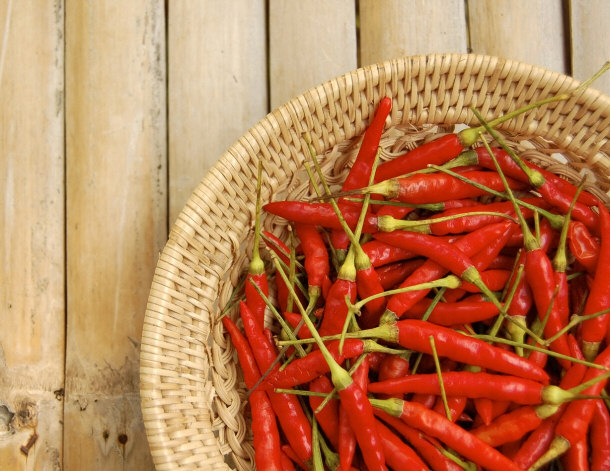
Finally, capsaicin in chili peppers helps to clear congestion from the lungs
and nasal passages. If you are congested from a cold or allergies, try making a
dish with some hot chilies. In addition to clearing away extra congestion, the
heat of peppers may be able to get through the dulled sensation of flavors you
have when fighting a cold, making some foods more palatable.
13) Cumin
Cumin is another spice with a long history, used over a wide area of the
Mediterranean to parts of China. In the European Middle Ages, it was one of the
most accessible spices and therefore one of the most popular. There are even
stories about soldiers carrying loaves of bread made with cumin off to war for
good luck!
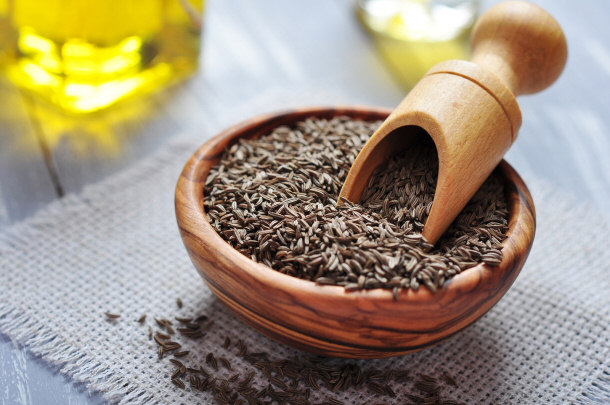
Cumin may or may not help to bring you home from war safely, but thankfully
it has a lot of benefits closer to home. It is a potent seed despite its small
size, and a little of it added to a dish can go a long way to changing its
flavor. It is being studied for its effects in the body's systems for managing
sugars, which makes it of great interest in treating diabetes. Studies using
animals have showed that cumin reduces cholesterol and triglycerides and eases
pancreatic inflammation. Other studies show cumin improving immune responses in
animals with stress-compromised immune systems. It reduced levels of cortisol
and adrenalin in the blood, chemicals which are closely related to stress
reactions.
Traditional medicine noted that cumin is good for the digestive system, and
modern medicine is finding this to be true as well. It is also a source of iron,
manganese, calcium, and magnesium.
12) Coriander or
Cilantro
This herb has two names. It is called coriander in India, but better known as
cilantro in the U.S. By whatever name, coriander is a common decorative garnish,
its pretty leaves adding a nice visual touch to dishes of all kinds. But don't
be too quick to push that garnish aside uneaten. Coriander is packed with
nutrition, including many essential oils and acid compounds (including ascorbic
acid, better known as Vitamin C) and several important minerals including iron
and magnesium.
Some of the essential oils in coriander are known to possess antirheumatic
and antiarthritic properties. Coriander can help to reduce the painful swelling
caused by these conditions. It can also help to reduce other kinds of swelling
by stimulating kidney function, helping to remove excess water from the body.

Coriander may be especially good for helping to heal a number of skin
disorders, such as eczema, dry skin and fungal infections. It is both antibiotic
and antimicrobial, helping to kill germs and funguses that cause skin
irritations or disease. It has some detoxifying properties, which are beneficial
both inside the body and when applied to the skin, because the skin is a big
part of the body's system for eliminating toxins. These properties also make
coriander useful for treating mouth ulcers, speeding up healing and preventing
them from getting worse. It is a common component in all-natural toothpastes
because of its antimicrobial properties, helping to protect the teeth and also
freshening breath.
11) Black Pepper
Along with salt, black pepper is the most commonly found spice on American
tables. Salt and pepper shakers are available in places where no other spice is
handy. This was not always the case. In medieval Europe, black pepper was rare
and coveted (cumin was used as a cheaper, more readily available substitute). In
other times and places, it has been used as currency and even presented to gods
as offerings.
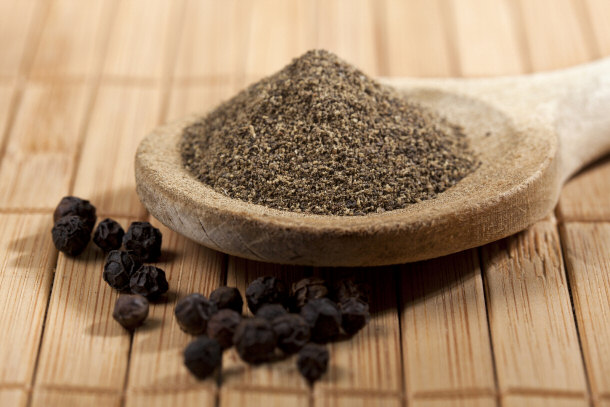
Today, this "king of spices" is recognized as a good source of iron,
manganese, copper and Vitamin K. It promotes digestion from the moment it hits
your tongue, stimulating the taste buds in such a way that the stomach begins to
increase production of hydrochloric acid. This doesn't sound promising on the
face of it, as hydrochloric acid is better known for its industrial uses as a
powerfully corrosive acid. But in fact hydrochloric acid is naturally produced
by the stomach and is vital for good digestion. If the stomach does not produce
enough acid, food may sit in the stomach for an extended period of time, causing
indigestion or heartburn. It's also possible for pieces of food to pass through
into the intestines without being properly broken down, which can result in gas,
diarrhea or constipation. All of these intestinal maladies can be avoided by the
stomach producing enough acid to process food, and eating black pepper helps
that process.
10) Cardamom
Cardamom is native to India's evergreen forests and commonly used in Indian
cuisine. It also became part of Indian medicine for treating various issues,
ranging from mouth ulcers to depression. Related to the ginger plant, cardamom
has many of the same digestive benefits as ginger, improving digestive function
throughout the body. It is a natural diuretic, meaning it induces the body to
release water and stimulates kidney function. This is a boost to the body's
detoxification process, flushing out the kidneys, bladder, and urinary tract and
removing wastes, extra salt and toxic substances in the process. It also helps
the body to fight infection, flushing away harmful microbes.
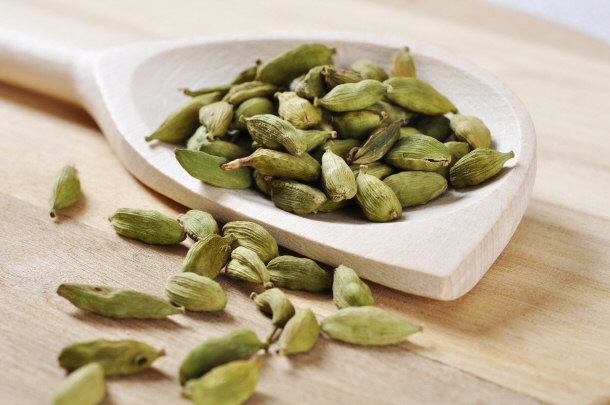
Cardamom supports good oral health, helping to quickly heal mouth ulcers and
other infections of the mouth and throat. It can relieve bronchitis and coughs,
and helps to fight cold and flu symptoms. It lowers blood pressure by removing
extra water from the body. And finally, it can even help to stop hiccups. It has
anti-spasmodic agents which can ease the diaphragm contractions that cause
hiccups, and also other involuntary muscle spasms.
9) Cloves
Cloves have a special place in U.S. cuisine during the autumn, adding warmth and
aroma to pumpkin pie and ginger bread, along with other fall classics. They are
actually native to Indonesia and have been a part of Indian cooking and other
Asian cuisines for thousands of years. Cloves are nutrient-dense, a marvelous
source of manganese, Omega-3 fatty acids, Vitamin K, Vitamin C and dietary
fiber, just to name a few.
Cloves have high anti-inflammatory and anti-oxidant properties. Studies have
shown that adding cloves to diets which are already high in inflammatory
compounds brings a marked reduction in further inflammation. It can help to
protect the body from toxic substances in the environment and has even shown
some benefit in fighting digestive-tract cancers.
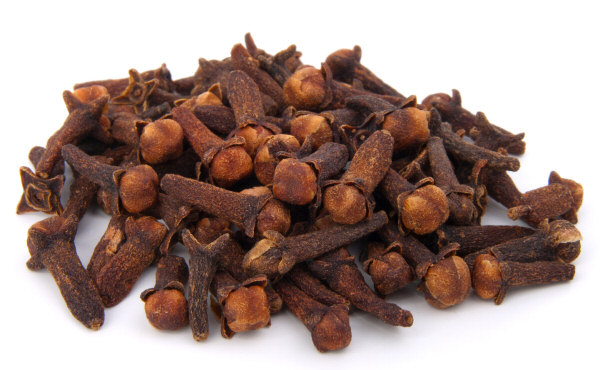
Extracts from cloves have found their way out of the kitchen and into
dentistry. A substance called eugenol, extracted from cloves, is used during
root canal procedures, in making temporary fillings, and for gum pain. Eugenol
combined with other substances found in cloves produces a natural, mild
anesthetic. It is also anti-bacterial. These two properties together make it
clear why clove extracts are so useful in dentistry, preventing pain and
supporting oral health.
8) Cinnamon
Cinnamon is a familiar ingredient in sweet desserts, but it plays a larger role
in Indian dishes. It also plays health roles as well. Cinnamon has some
anti-microbial properties, helping to protect against infections. It has a
preservative effect in foods, helping to stop harmful microbes from growing
there as well as in the body. It is a blood-thinner, helping to prevent harmful
blood clotting and support cardiovascular health.

One of the most significant roles of cinnamon in supporting health, however,
is in regulating blood sugar. Cinnamon slows the rate at which the stomach
breaks down food and empties after meals, which means sugars from your food
reach the bloodstream more slowly. This helps to avoid sugar spikes and crashes.
For people with diabetes, cinnamon improves the body's response to insulin, the
hormone which regulates sugar levels in the blood. Regulating sugar in the body
is a vital part of maintaining our health and energy levels, and in preventing
diabetes and other chronic diseases.
7) Bay Leaves
Bay leaves come from the bay laurel plant. This is the same plant from which the
Romans made laurel wreaths to crown their emperors, and where we still get the
idea of laurels as a symbol of excellence. The bay leaf offers excellent flavor
enhancements to soups and stews, and some wonderful health benefits as well.
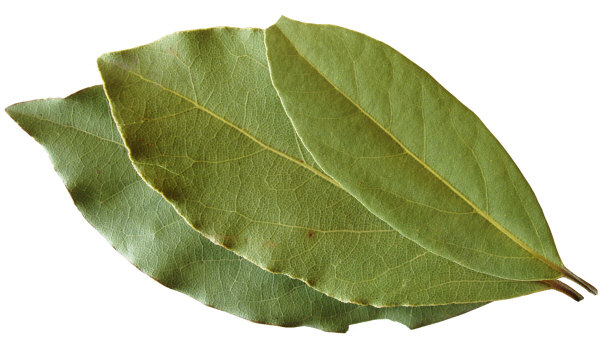
Bay leaves contain several nutrients that are common in this list of
health-enhancing spices, such as Vitamins A and C, iron, manganese, magnesium
and potassium. Bay leaves also contain eugenol, which as we saw with cloves, is
an anesthetic and anti-microbial agent. They help fight common colds and
other illnesses, killing germs and lessening symptoms.
Wound care also benefits from the properties of bay leaves. From antiquity,
bay leaves have been understood to help the body heal cuts and other wounds more
quickly. Modern science has determined that the leaves of bay laurel are
naturally anti-septic, helping to keep wounds clean and germ-free for faster
healing. A poultice of bay leaves does the job for cuts, and the oil of bay
leaves is good for sprains and bruises.
6) Nutmeg
Nutmeg is a natural complement for cinnamon in spicing up an apple pie. It is
also part of various Indian dishes. Its health benefits range from the gentle to
the profound. If you suffer from insomnia, drink a cup of milk sprinkled with
nutmeg powder. Nutmeg helps the body to relax and thus induces sleep. Nutmeg can
be used as a skin product to fight acne and promote smoother skin. Use a scrub
made from nutmeg mixed with orange lentil powder to remove blackheads, and
nutmeg mixed with honey to make a paste can help make the marks of acne on the
skin less noticeable.
Eat nutmeg to help digestive health and also to detox the liver and kidneys.
It helps to remove extra gas from the stomach and intestines and promotes the
healthy working of the entire digestive system, which also aids the liver’s
detoxification function. Nutmeg has been used in traditional Chinese medicine
for centuries as a pain reliever. It is effective to fight inflammation and to
ease abdominal pain. Nutmeg can also help to ease aching joints and muscle pain.

Finally, nutmeg can help to stimulate healthy brain function, which means it
can also help to relieve fatigue and stress. It may have beneficial effects
against depression and anxiety symptoms, and improves concentration levels,
vital for serious students and hard-working adults alike.
5) Saffron
Saffron is an ancient spice, used and cultivated for thousands of years, and it
remains the most expensive spice in the world today. Production of this spice is
extremely labor-intensive, and it takes up to 80,000 flowers of the saffron
crocus plant to produce just 500 grams of the dried spice. It may be too dear to
use every day or in large quantities, but saffron has also been recognized as a
medicinal plant from ancient times. Traditional medicine prescribed it for
stomach aches and kidney stones, and to improve blood circulation. Modern
research suggests that saffron may be anticarcinogenic, helping to protect
against the development of cancer in the body. There are also studies showing
that saffron may be especially good for protecting eye health. Saffron may
protect the eyes from harmful effects of bright sunlight, and it may also slow
down macular degeneration and help improve vision in people who suffer from
cataracts. One trial showed that every single person involved who took saffron
showed improvements in their vision.

4) Fennel
Fennel is often associated with Mediterranean cuisine, but it appears in Indian
dishes as well. The whole plant is edible from root to leaves, and it contains a
long list of nutrients and minerals, including Vitamin C, Vitamin B3, potassium,
manganese, folate, calcium, magnesium, iron, copper and a good dose of dietary
fiber.
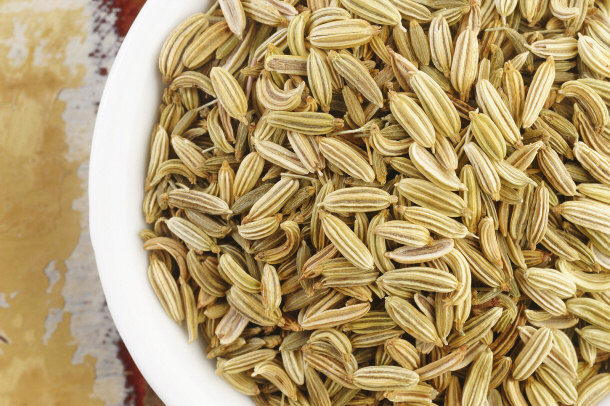
This plant contains a mix of phytonutrients, or naturally-developing chemical
compounds which grow in plants, which have especially good antioxidant
properties. Antioxidants are important for neutralizing molecules in the body
called free radicals. These molecules have an unbalanced chemical structure,
owning either too many or too few electrons, which gives them a negative or
positive charge. They bounce around in the body, trying to balance their
structure by shedding or stealing electrons, and in the process can damage
healthy cells, proteins or even DNA.
Antioxidants are substances which neutralize these free radicals, by
combining with them to form stable molecules and therefore removing their
ability to damage other cells. Free radicals are always present in our bodies,
as some of our most basic bodily functions create them (including breathing). So
we always need to consume a range of antioxidants like those present in fennel
to neutralize these free radicals and protect our bodies from excessive damage.
3) Oregano
This herb belongs to the mint family, though its flavor is much sharper and more
pungent than many kinds of mint. But oregano gives a lovely boost to many
dishes, including lots of Indian cuisine, and also great health effects.
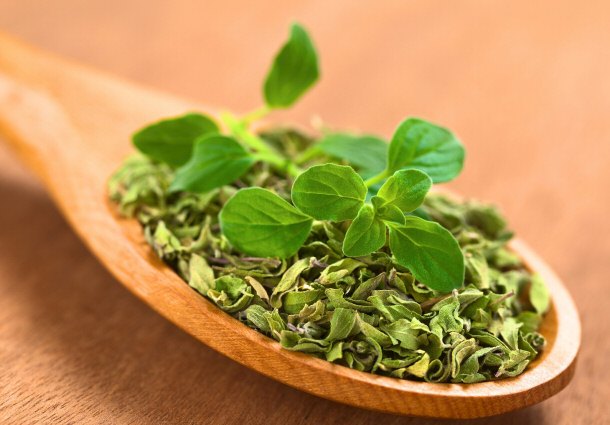
Oregano has a good combination of iron, manganese and Vitamin A and it is
good for boosting immune health. Some of the compounds present in oregano help
to relieve upset stomachs and other digestive ailments. Chewing a few leaves of
fresh oregano can help to relieve menstrual cramps and can be taken for several
days if symptoms persist. It also relieves severe congestion in the lungs.
Instead of eating fresh or dried oregano, some of these benefits can be
obtained from oregano oil. Add a few drops to a glass of water or use it
topically to aid in fighting skin infections. But don’t miss out on oregano’s
punch in food either, in dishes which can range from the Mediterranean to the
Pacific!
2) Garlic
Several medical studies have sought to identify diets associated with good
hearth health. These diets generally include plentiful fruits and vegetables,
which is no surprise. But so far, the common spice found between all such diets
is garlic. Many ancient cultures, Indians among them, have used it as both spice
and medicine. Medical studies have confirmed that garlic has significant
benefits in preventing or slowing cardiovascular disease. Garlic reduces
cholesterol and increases anti-oxidants. It is a natural blood-thinner,
inhibiting the formation of dangerous blood clots, and can also help to reduce
blood pressure.

Garlic helps the body to absorb iron, a vital ingredient in a healthy blood
system. Iron is a key component of hemoglobin, the substance which enables your
blood cells to carry oxygen from the lungs throughout the body. Without enough
iron, you may find yourself getting tired and winded, no matter if you are
otherwise in great shape. Garlic also has anti-microbial and anti-fungal
properties. It can help the body to overcome infections and colds, and can be
used to treat skin conditions resulting from fungal infections. Some new studies
are focusing on garlic's influence on the development of fat cells in the body.
Early-stage research shows that garlic may help to regulate the number of fat
cells the body creates, which could help maintain a healthy weight and boost
overall health. Finally, garlic contains compounds which might inhibit the
development of cancer.
1) Turmeric
Turmeric goes back a long way in Indian and Chinese medicine. It was recognized
as an anti-inflammatory agent and prescribed to treat a wide range of issues
including chest pains, menstrual problems, healing wounds, stomach and liver
problems, even toothaches and gas! Today turmeric has been shown to reduce
cholesterol and to lower high concentrations of triglycerides, both of which are
important in treating the effects of obesity and in helping people to reduce
their weight. Its anti-inflammatory properties could help in treating many
illnesses, because inflammation is increasingly recognized as a factor in nearly
every form of chronic disease.
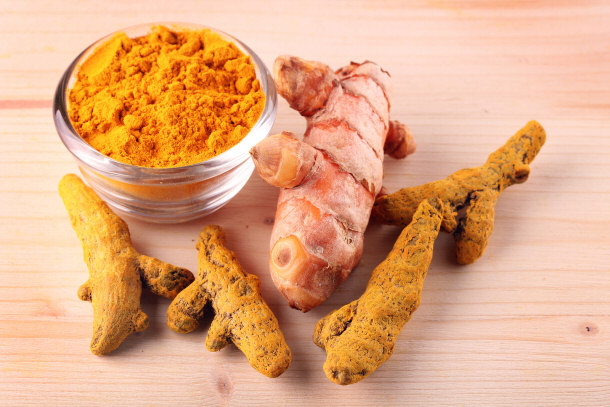
Inflammation is a natural part of the body's defense system against harmful
infection. Sore throats and rashes are caused by healthy inflammation. But it's
possible for inflammation to run out of control. Allergies, asthma, and
rheumatoid arthritis are examples of what happens when inflammation gets out of
hand. Even more seriously, heart disease, obesity, diabetes and other chronic
illnesses have inflammation as one of their sources. Traditional Indian medicine
is right in prescribing turmeric and other naturally anti-inflammatory foods or
spices for a long list of illnesses.
Conclusion
These and other spices clearly help the body to thrive, keeping our natural
systems in balance and defending us against microbial invaders. All of this
comes on top of making Indian food, and foods from other cuisines, taste great.
It's not hard to take your medicine when it comes like this: with fresh foods
and a lot of variety of flavors!
Just like any kind of medicine, be aware that taking more is not always
better. If you are dealing with heart disease, eating more garlic is not going
to make everything better by itself. Too much of any particular spice could
cause your body to react in negative ways, and if you are already taking
medications, too much of a spice that interacts badly with that medicine could
be bad news indeed.
The best way to enjoy the valuable health benefits of these and all spices is
to incorporate them in a healthy, balanced diet. Take the example of Indian food
and eat lots of different foods, including a large variety of fruits and
vegetables along with lean meats and whole grains. If you don't cook at home,
it's easier than you think! Learn some basic skills and start exploring these
and other spices. Search out simple Indian dishes to get you started on your
flavor exploration, and in the process, you'll give your body more of what it
needs to be strong, healthy, and vitally alive.
Diet & Nutrition
Top Lists:
Top 15 Foods That Help Migraines
24 Food Additives That You Should Consider Avoiding
Top 15 Healthy Spices From India
15 Disgusting Ingredients In Your Food
15 Best Foods For Brain Health
15 Foods That Are Surprisingly Good for You
Top 15 Organic Produce That's Better Than Conventional
15 Weird Interesting Facts About Vegetables
10 Best Cleansing & Detoxifying Foods
Informational:
Evaluating Diet Plans: Which One is Right for You?
The Essential Health Benefits of Ginger
The Health Benefits of Kale
Top Natural Appetite Suppressants That Will Help You Lose Weight
Almond: The Magic Pill For Hunger, Weight Loss and Cholesterol
How Effective is Phen375 in Losing Fat?
What Are Health and Losing Weight Benefits of Unique Hoodia?
Organic Foods – Are they better than Conventional Foods?
Facts about Alcohol
Best Ways to Get a Good Night’s Sleep
General Benefits of Green Tea
Health Benefits of Inositol Supplements
Anti-Aging Foods to Stay Young
Who is Responsible For Overweight Children?
My Secret to Losing 100 Pounds in 6 Months
How and When to Use HCA Extract? |